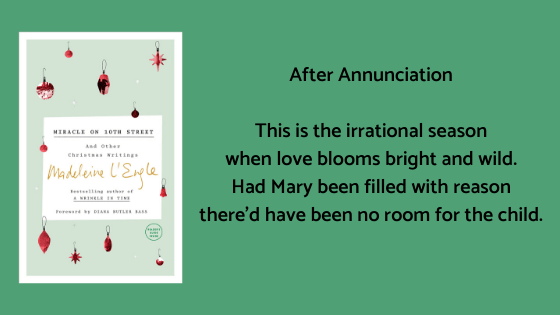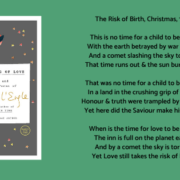Convergent re-releases MIRACLE ON 10TH STREET, collection of Christmas poems, stories
Dear Ones,
On the way to work, I pass a house with a sign out front: “REMEMBER: Jesus is the Reason for the Season.” The sign’s a common enough sight in the Midwest every December … but I wonder as I drive by: Wouldn’t Madeleine have found that yard sign lacking?
For Christians, Jesus certainly plays a leading part in the season. But can we claim to be able to sum up the reason for the season in one word (or one Word)? What of the waiting, the recognition of God in the flesh and living among us now? What about redemption — and the party? What of the “glorious mysteries” inherent to a season where God comes to earth via a teenage girl, a virgin?
All these things are explored in poems, reflections, and short stories in the new edition of Miracle on 10th Street: And Other Christmas Writings. The book released in late October by Convergent Books, bearing a new foreword by Diana Butler Bass (most recently, Grateful: The Transformative Power of Giving Thanks) and readers’ guide by Lindsay Lackey (All the Impossible Things). Some of Madeleine’s words are unpublished elsewhere; others are excerpted from her 40 years of work, including two Austin Family stories.
As Butler Bass writes, Madeleine doesn’t “scold” readers into remembering the real meaning of Christmas. Instead, she asks us to contemplate the ordinariness of our days and just to wonder: whoa — God put on skin and joined us here. Butler Bass credits Madeleine’s focus on the incarnation to her Anglican faith. Anglicans are “Christmas people,” she writes, whose God has a certain “with-ness.”
“Anglicanism believes in a king who finds a stable and manger the most suitable of birthplaces, and who fetes his friends by serving up a simple meal of bread and wine,” she says in the foreword. “This is, more than anything else, a homey faith, a spirituality of humanness and hospitality.”
Readers will find evidence of a “homey faith” in Madeleine’s ruminations on icons, motherhood, her creative Creator, chaos and cosmos, and the interdependence of all creation. Madeleine’s curiosity about “glorious mysteries” keep the collection from sentimentality and religiosity. But while we’re exhorting each other to “remember,” consider Mary was a teenage virgin, bearing a son in a cave. The Christmas story is not a logical one:
“Had Mary been filled with reason / There’d have been no room for the child …,” Madeleine writes in the poem “After Annunciation.”
Had the Christmas story been filled with reason, there’d be no room for mystery. Maybe if we’re going to remember anything this season — yard-sign theology or not — it’s just that we can’t begin to understand every gift of the season. As only Madeleine could pen it in the reflection called “Such Smallness”:
“The neutrino and the unicorn
danced the night that Christ was born.”
And I’ve not seen either of those things on a yard sign yet this season.
Tesser well,
Erin F. Wasinger, for MadeleineLEngle.com.




